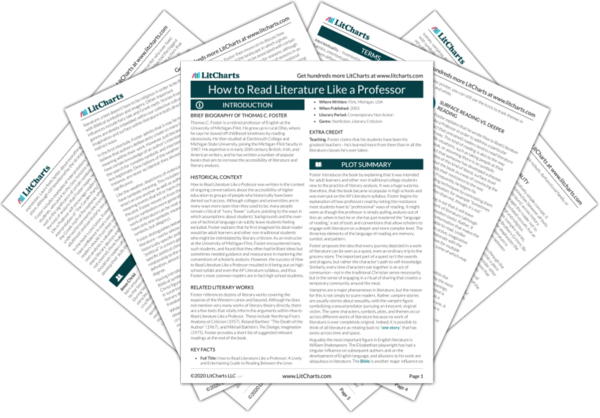William Shakespeare was a British playwright and poet born in Stratford-Upon-Avon in 1564. He is thought to have written 38 plays and 154 sonnets, although there is some disagreement over whether all Shakespeare’s plays are correctly attributed and whether he was in fact more than one person. Some of Shakespeare’s most famous plays include Romeo and Juliet, Macbeth, Hamlet, King Lear, and A Midsummer Night’s Dream. He had a singular impact on the development of English language and literature, and is considered by many to be the greatest writer who ever lived. Indeed, Foster suggests that Shakespeare has had the biggest impact on Western literature of any single author, a claim that is widely agreed upon within the academic community. In Chapter 5, Foster argues that Shakespeare’s work is so deeply embedded within our culture that readers may well have already encountered a Shakespearean reference today.
Get the entire Read Like a Professor LitChart as a printable PDF.

William Shakespeare Character Timeline in How to Read Literature Like a Professor
The timeline below shows where the character William Shakespeare appears in How to Read Literature Like a Professor. The colored dots and icons indicate which themes are associated with that appearance.
Chapter 3: Nice to Eat You: Acts of Vampires
...convey a message or teach living characters a lesson—this is true of the ghosts in Shakespeare’s Hamlet (1605) and Dickens’ A Christmas Carol (1843). Doppelgangers, on the other hand, emphasize the...
(full context)
Chapter 4: Now, Where Have I Seen Her Before?
...can be difficult to untangle. Angela Carter’s novel Wise Children (1992) portrays a family of Shakespearean actors whose lives imitate, parallel, and at times pervert narratives from Shakespeare’s plays. Carter anticipates...
(full context)
Chapter 5: When in Doubt, It’s from Shakespeare…
The plays of William Shakespeare have been endlessly adapted, transformed, and used loosely as inspiration for a countless number of...
(full context)
Of all the Shakespearean-inflected works, Foster declares that his favorite is Angela Carter’s Wise Children (1992), which he first...
(full context)
Foster argues that part of the reason why Shakespeare is so popular is because writers are obsessed with him. Quoting Shakespeare makes you seem...
(full context)
Another, less obvious reason why writers love Shakespeare is because they can “struggle” against him. The (sometimes fraught) relationship of writers to their...
(full context)
One example of a writer reworking Shakespeare is the South African writer Athol Fugard in his play Master Harold… and the Boys...
(full context)
Chapter 6: …Or the Bible
Just as writers everywhere have been reworking and responding to Shakespeare’s work since his death, so too has the Bible played a fundamental role in the...
(full context)
Chapter 7: Hanseldee and Greteldum
...could be as subtle as “the sense of lostness” or the danger of temptation. Like Shakespeare and the Bible, fairy tales are all part of “one big story” and so are...
(full context)
Chapter 8: It’s Greek to Me
Shakespeare, the Bible, and fairy tales are all types of myth. That doesn’t mean they are...
(full context)
Chapter 10: Never Stand Next to the Hero
...Tom Stoppard’s play Rosencrantz and Guildenstern Are Dead (1966), which borrows its titular characters from Shakespeare’s Hamlet.
(full context)
Interlude: Does He Mean That?
...received extensive education in the classics and the work of poets such as Dante and Shakespeare. Furthermore, writers tend to be “aggressive readers” whose love of literature means they are familiar...
(full context)
Chapter 20: …So Does Season
Foster quotes from Shakespeare’s sonnet 73, in which a man compares his coming old age to the shift from...
(full context)
Chapter 24: Don’t Read with Your Eyes
Another example: Shakespeare’s The Merchant of Venice (1605) is certainly anti-Semitic from a contemporary perspective, but it was...
(full context)












